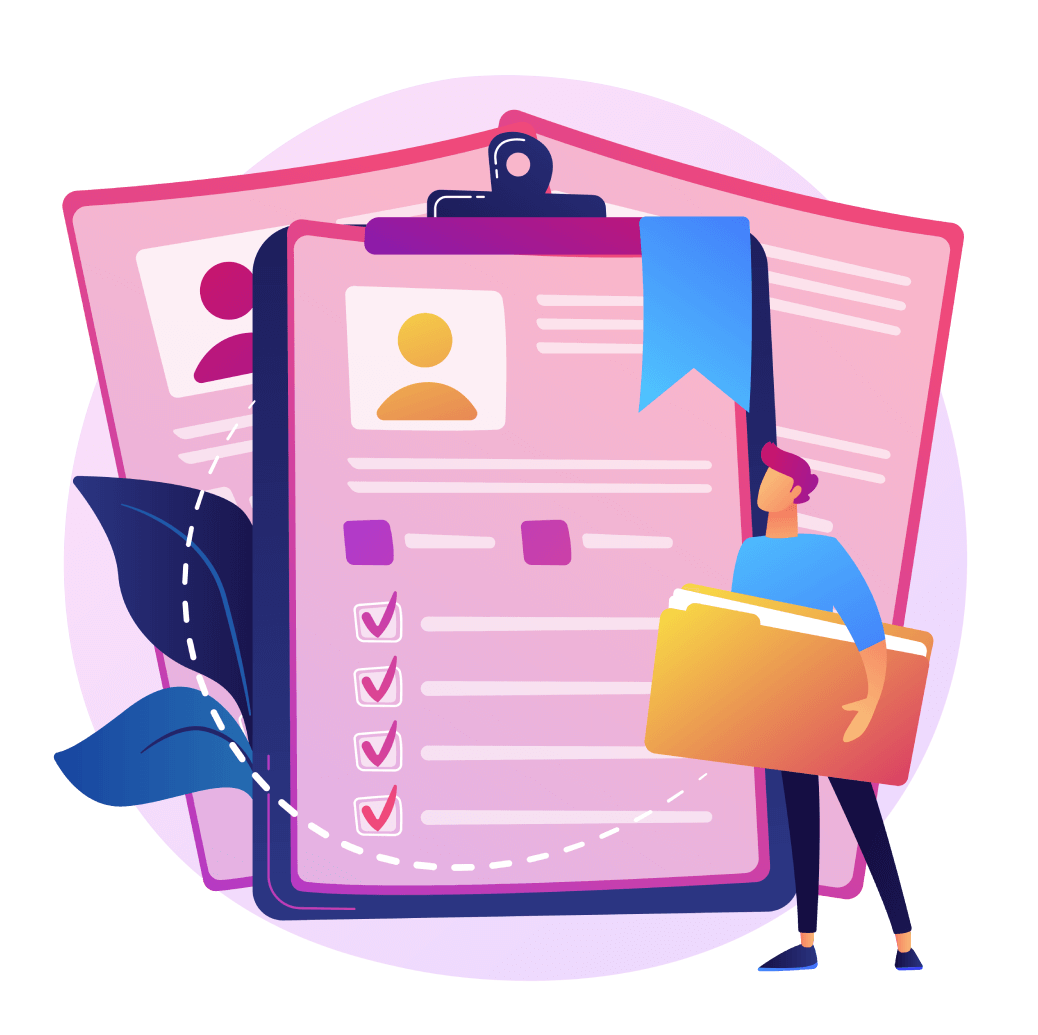Candidate Journey Map:
What It Is and How to Make One
With such a wide range of employers to choose from, the best candidates today are no different from your best customers. Top candidates discover new opportunities through social and personal networks, expect a great candidate experience, and respond to organizations whose values resonate with them.
Many HR managers and business leaders have discovered the wonders of a candidate journey map. A seamless and pleasant candidate journey will have applicants singing praises and eager to get on board. An impersonal and inefficient one will send them running in the opposite direction and warning their network to do the same. According to a survey, 72% of job seekers report sharing bad candidate experiences on review sites, social media, or directly with friends and colleagues.
With today’s fierce competition, it’s important for employers to offer a stellar candidate experience with a journey map that runs smoothly and meets all the needs of applicants.
On this page, we guide you through the stages of the candidate journey and provide you with a candidate journey map template that helps your hiring team achieve recruitment success.


What is a Candidate Journey Map?
Before anything else, let’s first describe the definition and essence of a candidate journey map.
A candidate journey map is basically a visual representation of a candidate journey. It tackles all the touchpoints candidates have with your brand during different stages of their candidate journey.
Having a candidate journey map template is important to enhance your company’s employer branding strategy and improve the overall candidate experience. It helps you further understand the needs, wants, and expectations of applicants in different phases of their journey.
Aside from providing a great candidate experience, a journey map also serves as your guide for a better online recruitment marketing strategy. You will discover which type of content works best at every stage of the candidate journey map and how to showcase your employer brand across various channels.
A Deeper Look into the Candidate Journey Map
When creating a candidate journey map template, it’s important to understand the stages in your candidate journey. Let’s go through each of them.
Seven stages of a candidate journey map:
1. Awareness
These are the first few touchpoints a candidate has with your company. These touchpoints make applicants aware of who you are, what you do, and the culture in your organization. In this stage, candidates are just getting to know you. Possible touchpoints could be viewing your job ads, visiting your career site, or talking to a company representative at a job fair.
2. Consideration
In the consideration stage of the candidate journey map, candidates start determining whether they are interested or not in working for your company. During this stage, they may have additional points of contact or touchpoints such as visiting your Careers Page or talking to a current employee. With the help of referral recruitment software, you can empower your employees with a referral program that further pushes applicants from the Consideration stage to the next steps in the candidate journey.
3. Interest
At this stage, potential candidates are now genuinely interested in working for your company. They are likely to apply unless something intervenes, such as getting a job offer from another company. Common touchpoints for this stage of the candidate journey map include job seekers emailing you questions about the open position or clicking on retargeted job ads.
4. Application
This stage starts when candidates fill out your application form on your Careers page and end when they are accepted or rejected. The way you communicate with candidates during this stage is crucial as it influences their perception of your company.
If you have a Careers page, make sure it’s optimized and looks professional. You can easily do this with job portal website development. Face to face communication is also a vital touchpoint. Interviews are the perfect opportunity to show candidates what your company is all about and why they should choose you as their next employer.
5. Selection
This happens right after the interview. At this point, you’re evaluating your candidates based on their performance during the interviews. While most companies simply let their candidates wait during the Selection stage, you can still generate touchpoints to improve the overall candidate experience.
For instance, you can send a thank-you email to candidates stating you appreciate their time and effort. You can also let them know how long it will take before you make your final decision.
6. Hiring
The last step in the application phase. However, this is not the last stage of your candidate journey map, especially if you want to provide a stellar candidate experience. Touchpoints for this stage include calling or emailing your candidate about your decision. If a candidate is rejected, make sure you inform them why they didn’t make the cut. When you’re transparent with your candidates, this greatly improves their impression of you.
7. Onboarding
Onboarding your candidate is a vital method of ensuring a consistently great candidate experience throughout your journey map. It has a huge impact on whether your candidate stays at your company even after the probationary period.
As a recruiter, you should already be thinking about your onboarding process before you hire. After all, you don’t want to lose an employee in just a month after you’ve spent so much time, effort, and resources on recruiting them. The overall costs of hiring an employee can take a huge toll if you don’t onboard them properly.
How to Create a Candidate Journey Map Template
Making a candidate journey map template is best done with collaborative efforts. It typically involves three steps:
The first thing you need to do is to determine the type of candidate whose journey you are mapping. In other words, you have to create your candidate persona.
The persona of your candidate journey map template is basically a semi-fictional representation of your ideal candidate. The persona is formed by specific skills, traits, goals, values, expectations, and experiences of your perfect hire.
To identify your candidate persona, start with the data you’ve already collected. Analytics from your HR recruitment software and results from candidate feedback surveys are extremely helpful.

Qualitative research is also valuable. Consider conducting informational interviews with fresh hires or candidates who declined your job offer. Get the individuals to share their stories. For instance, what kind of career growth do they anticipate with the company? What did they feel at every step of their candidate journey?
Pro tip: Collate all your research into a detailed portrait of your candidate person. This allows you to understand the person whose candidate experience you are visualizing.
The different stages of the candidate journey described above form the basis of your candidate journey map template. The stages are universally applicable as all candidates go through each step, regardless of the company they apply to.
The basis of every step in the candidate journey map is made up of the needs of your candidates. To create a proper candidate journey map template, you will need to mull over what their needs are, as well as the thoughts and feelings that drive your candidates’ behavior. For example, these thoughts might be:
- Awareness: Who is this company? What do they do?
- Consideration: What kind of career growth do I anticipate with this company? How will they help me further advance my skills?
- Interest: What makes this company better than the rest? What’s the work culture like?
- Application: Did the company receive my application? Will I be contacted for an interview?
- Selection: Did I get a good impression of the company? Did I do a great job during the interview?
- Hiring: Will I like my new co-workers?
- Onboarding: What are my day-to-day tasks? What tools will I use? Who will I report to?
Understanding the thoughts and needs of your candidates will help you understand your candidate journey map a lot better. It also helps you come up with solutions to their needs.
For instance, during the application period, you can invest in candidate scheduling software that automates interview scheduling. This ensures your candidates always receive constant updates about their interviews.
Another example is for the consideration stage. You can post an infographic on your Careers page that showcases a typical career path in one of the openings at your company. You can also post an article that highlights a current employee’s journey with your company.

To provide a truly great candidate experience with your journey map, identify the touchpoints between your company and your candidates. As mentioned earlier, touchpoints refer to the interactions candidates have with your company.
The number of possible touchpoints is endless, especially during the first stages of the candidate journey. This makes it hard to map out each and every single touchpoint, which is why your candidate persona is useful. Think about the behaviors of your candidate persona: Which recruiting channels do they visit often? Are they active on social media or present in career fairs? Try to include at least three to five touchpoints for each stage in your candidate journey map template.
Create Your Candidate Journey Map Today
After mapping out your candidate journey, create a graphic visualization! There’s no right or wrong way to do this. All you need is to gather all of the information we’ve tackled and then combine them in a candidate journey map template.
Some HR teams create a candidate journey map using post-its. Others map it out on a whiteboard with markers. The choice is up to you. The important thing is that your visual candidate journey map combines all the valuable insights you’ve gathered into a format that’s easy to understand and simple to digest.
Once you have a good overview of your candidate journey, you can identify bottlenecks in your recruitment process, improve your hiring decisions, and ultimately shorten your time to hire.

Hire faster, hire easier.
For more information and inquiries about our recruitment management software, reach out to us and fill up our contact form.

